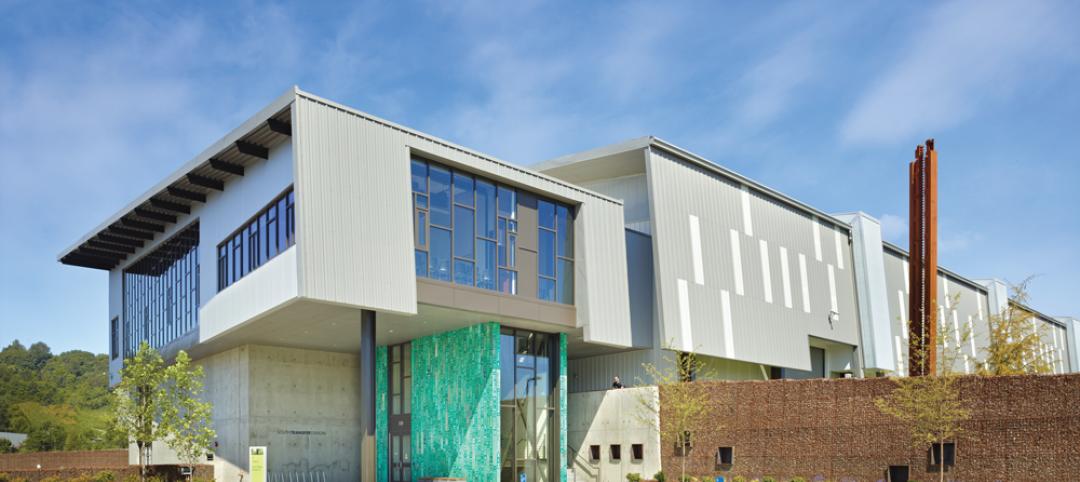
After more than a century without a substantial renovation, Old Suffolk County Courthouse, designed in Neo-Classical style by Boston's first city architect, George Clough, was overdue for a facelift.
 |
| Smothered by decades of coal dust, smoke, and pollutants, the ornate, gilded ceiling of the Great Hall at Boston’s Old Suffolk County Courthouse was carefully restored in a $117 million renovation. The courthouse was renamed John Adams Courthouse following the 43-month project. PHOTO: JONATHAN HILLYER PHOTOGRAPHY |
Enter the makeover team: Boston-based architects Childs, Bertman, Tseckares and general contractors Suffolk Construction/NER Construction Management. Their patient: a courthouse built between 1886 and 1894 and nowhere close to being ADA-compliant, too small to handle the needs of the Massachusetts High Courts, and sporting woefully out-of-date electrical, HVAC, and communications systems.
The team's efforts focused heavily on preservation and restoration because the courthouse was listed on the state and national historic registers, which meant that simple matters had to be addressed in smarter ways. After more than 100 years, its space needs had changed, not only for its judicial function, but also to accommodate security systems and automobile parking. Ordinarily, the solution would have been to loosen the girdle and letting the building expand. But here, the team had to find a way to add square feet within the parameters of the courthouse's original footprint—effectively plumping up the building while still managing to fit it into last season's pants.
To accomplish that goal, the Building Team headed for the light wells. Outdated since the advent of modern lighting systems, parts of the courthouse's two largest wells were converted into 50,000 square feet of usable space for the Massachusetts Supreme Judicial Court and the state Social Law Library.
Meanwhile, new underground parking was inserted into the building's lowest level, giving the state's highest judicial members direct access from their cars to their chambers. The team also moved most major court functions to the second and third floors and reorganized the entry level to celebrate the Great Hall, a soaring four-story public space.
The Great Hall was also a major focus of the team's renovation efforts. Architectural details that were smothered by decades of coal dust, smoke, and pollutants were cleaned inch by inch, as was the decorative ceiling with its intricate, gilded floral abstract pattern bordered by arches and columns decorated with rosettes, egg and dart borders, and classical figures cast in plaster. Damaged areas were infill-painted using reversible materials, saving as much of the original art as possible.
Courtrooms were also heavily renovated. Drop ceilings from the 1960s were removed to reveal original plaster moldings. For the wall and woodwork restoration, the team turned to old photographs that documented original vibrant paint schemes, Victorian stencil work, and light-colored, lustrous wood finish. Modern, efficient versions of historic lamps and lighting fixtures completed the transformation.
When the dust settled and the nipping and tucking was finished, the now-344,285-sf courthouse was so transformed that officials decided it needed a new name. The Old Suffolk County Courthouse was reborn as the John Adams Courthouse.
Related Stories
| Jul 18, 2013
Top Government Sector Engineering Firms [2013 Giants 300 Report]
Fluor, URS, AECOM top Building Design+Construction's 2013 ranking of the largest government sector engineering and engineering/architecture firms in the U.S.
| Jul 18, 2013
Top Government Sector Architecture Firms [2013 Giants 300 Report]
Stantec, HOK, HDR top Building Design+Construction's 2013 ranking of the largest government sector architecture and architecture/engineering firms in the U.S.
| Jul 18, 2013
GSA regains stature under Tangherlini, who looks to trim its holdings, cut energy costs [2013 Giants 300 Report]
Over the past 15 months, Acting GSA Administrator Dan Tangherlini has done a creditable job of restoring the agency’s standing with Congress and the public.
| Jul 2, 2013
LEED v4 gets green light, will launch this fall
The U.S. Green Building Council membership has voted to adopt LEED v4, the next update to the world’s premier green building rating system.
| Jul 1, 2013
Report: Global construction market to reach $15 trillion by 2025
A new report released today forecasts the volume of construction output will grow by more than 70% to $15 trillion worldwide by 2025.
| Jun 28, 2013
Building owners cite BIM/VDC as 'most exciting trend' in facilities management, says Mortenson report
A recent survey of more than 60 building owners and facility management professionals by Mortenson Construction shows that BIM/VDC is top of mind among owner professionals.
| Jun 5, 2013
USGBC: Free LEED certification for projects in new markets
In an effort to accelerate sustainable development around the world, the U.S. Green Building Council is offering free LEED certification to the first projects to certify in the 112 countries where LEED has yet to take root.
| Jun 3, 2013
Construction spending inches upward in April
The U.S. Census Bureau of the Department of Commerce announced today that construction spending during April 2013 was estimated at a seasonally adjusted annual rate of $860.8 billion, 0.4 percent above the revised March estimate of $857.7 billion.
| May 3, 2013
'LEED for all GSA buildings,' says GSA Green Building Advisory Committee
The Green Building Advisory Committee established by the General Services Administration, officially recommended to GSA that the LEED green building certification system be used for all GSA buildings as the best measure of building efficiency.
| May 1, 2013
Groups urge Congress: Keep energy conservation requirements for government buildings
More than 350 companies urge rejection of special interest efforts to gut key parts of Energy Independence and Security Act














